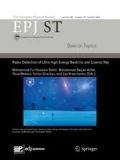Abstract
We are in the middle of a crucial debate whether Economics is really a natural science, which concerns the description and understanding of natural phenomena, based on observations and empirical evidence. In this article I discuss why it is hard to address this topic, by touching upon the cultural aspects of social and natural sciences, and highlighting their differences. As these differences lessen, Economics will be increasingly accepted as a part of natural science.
Similar content being viewed by others
References
A.S. Eichner, Why economics is not yet a science, J. Econ. Issues 17, 507 (1983)
H.E. Stanley, V. Afanasyev, L.A.N. Amaral, S.V. Buldyrev, A.L. Goldberger, S. Havlin, H. Leschhorn, P. Maass, R.N. Mantegna, C.-K. Peng, P.A. Prince, M.A. Salinger, M.H.R. Stanley, G.M. Viswanathan, Anomalous fluctuations in the dynamics of complex systems: from DNA and physiology to econophysics, Physica A 224, 302 (1996)
R.N. Mantegna, H.E. Stanley, Introduction to Econophysics: Correlations and Complexity in Finance (Cambridge University Press, Cambridge, 2000)
S. Sinha, A. Chatterjee, A. Chakraborti, B.K. Chakrabarti, Econophysics: An Introduction (Wiley-VCH, Berlin, 2010)
A. Quetelet, Sur l‗homme et le développement de ses facultés ou essai de physique sociale, Volume 1 (Bachelier, 1835)
A. Comte, Social Physics: From the Positive Philosophy of Auguste Comte (C. Blanchard, New York, 1856)
L. Bachelier, Théorie de la spéculation (Gauthier-Villars, 1900)
A. Einstein, Über die von der molekularkinetischen Theorie der Wärme geforderte Bewegung von in ruhenden Flüssigkeiten suspendierten Teilchen, Ann. Phys. 17, 549 (1905)
M. Smoluchowski, Zur kinetischen Theorie der Brownschen Molekularbewegung und der Suspensionen, Ann. Phys. 21, 756 (1906)
J.D. Farmer, M. Shubik, E. Smith, Is economics the next physical science? Phys. Today 58, 37 (2005)
A. Chakraborti, D. Challet, A. Chatterjee, M. Marsili, Y.-C. Zhang, B.K. Chakrabarti, Statistical mechanics of competitive resource allocation using agent-based models, Phys. Rep. 552, 1 (2015)
J.J. Binney, N.J. Dowrick, A.J. Fisher, M.E.J. Newman, The Theory of Critical Phenomena: An Introduction to the Renormalization Group (Oxford University Press, Oxford, 1992)
P. Ball, The physical modelling of human social systems, Complexus 1, 190 (2004)
M. Buchanan, Forecast: What Physics, Meteorology, and the Natural Sciences Can Teach Us About Economics (Bloomsbury Publishing USA, 2013)
B.B. Mandelbrot, Fractals and Scaling in Finance, Discontinuity, Concentration, Risk. Selecta Volume E (Springer, New York, 1997)
X. Gabaix, P. Gopikrishnan, V. Plerou, H.E. Stanley, A theory of power-law distributions in financial market fluctuations, Nature 423, 267 (2003)
M.H.R. Stanley, L.A.N. Amaral, S.V. Buldyrev, S. Havlin, H. Leschhorn, P. Maass, M.A. Salinger, H.E. Stanley, Scaling behaviour in the growth of companies, Nature 379, 804 (1996)
J-P. Bouchaud, M. Potters, Theory of Financial Risk and Derivative Pricing: from Statistical Physics to Risk Management (Cambridge University Press, Cambridge, UK, 2000)
D. Sornette, Why Stock Markets Crash: Critical Events in Complex Financial Systems (Princeton University Press, Princeton, 2009)
V.M. Yakovenko, J. Barkley Rosser Jr., Statistical mechanics of money, wealth and income, Rev. Mod. Phys. 81, 1703 (2009)
B.K. Chakrabarti, A. Chakraborti, S.R. Chakravarty, A. Chatterjee, Econophysics of Income and Wealth Distributions (Cambridge University Press, Cambridge, 2013)
V. Pareto, Cours d‗économie politique (Rouge, Lausanne, 1897)
A. Chatterjee, B.K. Chakrabarti, Kinetic exchange models for income and wealth distributions, Eur. Phys. J. B 60, 135 (2007)
T. Lux, F. Westerhoff, Economics crisis, Nature Phys. 5, 2 (2009)
P.M. Chaikin, T.C. Lubensky, Principles of Condensed Matter Physics (Cambridge University Press, Cambridge, 1995)
J.P. Sethna, Statistical Mechanics: Entropy, Order Parameters, and Complexity (Oxford University Press, Oxford, 2006)
K. Binder, A.P. Young, Spin glasses: Experimental facts, theoretical concepts, and open questions, Rev. Mod. Phys. 58, 801 (1986)
D. Challet, M. Marsili, Y.-C. Zhang. Minority Games: Interacting Agents in Financial Markets (Oxford University Press, Oxford, 2004)
T. Veblen, Why is economics not an evolutionary science? Q. J. Econ. 12, 373 (1898)
M. Schabas, The Natural Origins of Economics (University Chicago Press, 2009)
Author information
Authors and Affiliations
Corresponding author
Rights and permissions
About this article
Cite this article
Chatterjee, A. Is it “natural” to expect economics to become a part of the natural sciences?. Eur. Phys. J. Spec. Top. 225, 3145–3149 (2016). https://doi.org/10.1140/epjst/e2016-60157-0
Received:
Revised:
Published:
Issue Date:
DOI: https://doi.org/10.1140/epjst/e2016-60157-0



